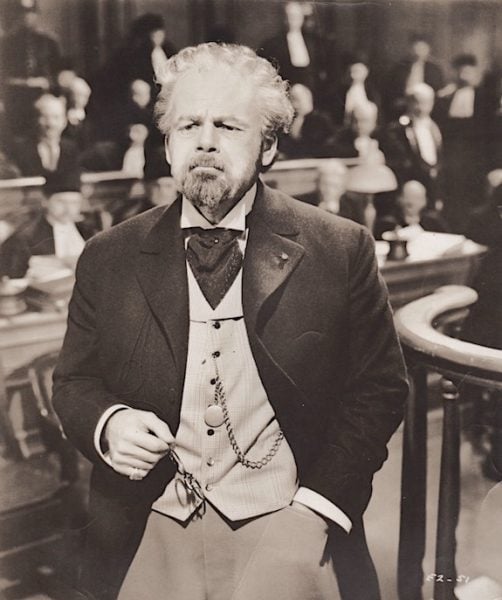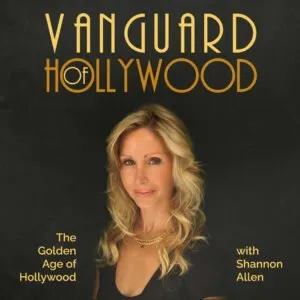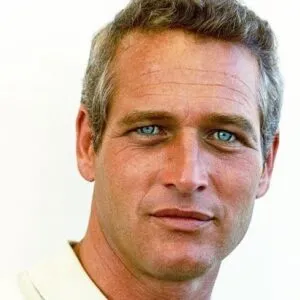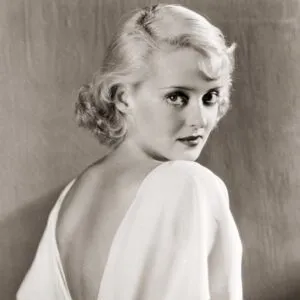The Life of Emile Zola (1937) was arguably the greatest performance of Paul Muni’s career. Based on the life of the renowned French writer, Muni impressively plays Zola as a young man, middle-aged man, and an old man in the film.
You can rent or purchase The Life of Emile Zola here on Amazon [aff. link].
Let’s go through the plot, then behind the scenes of the film.

The Plot
The Life of Emile Zola (1937) is, as mentioned above, a biographical film about the great French writer. Set in the mid 1800s to the early 1900s, Muni plays Zola, first as a young man struggling to earn a living while staying true to his art. We see Zola’s friendship with the artist Paul Cezanne (Vladimir Sokoloff).

We watch as the young Zola weds his sweetheart, Alexandrine (Gloria Holden), and finally becomes a success with the publication of his novel, Nana. The success of Nana brings about the financial security Zola has desperately hoped for, and he continues to write prolifically, becoming very wealthy over the years.

Complacency
As a middle-aged man who’s tasted great success, Zola is warned by his good friend Cezanne that he’s grown complacent, something an artist should never do:
“You’ve come a long way from the days when we started together in an attic…Emile, an artist should remain poor. Otherwise his talent, like his stomach, grows fat and stuffy.”
It’s almost the call to action Zola needs. He continues writing, but he’s not taking the risks he once did as a young man with nothing to lose.

But soon Zola heeds the words of Cezanne, and takes a risk when he speaks out against the injustice of the Dreyfus Affair. In so doing, Zola sets himself up for a charge of libel.
Zola’s involvement in this watershed case makes up the bulk of the film, and it’s one of the reasons why The Life of Emile Zola isn’t your run of the mill biographical movie.

The Dreyfus Affair
The Dreyfus Affair began in 1894 when it was discovered that there was a traitor in the French Army, a spy sharing French military secrets and strategy with the Germans. French Army officials quickly decided that the spy had to be Captain Alfred Dreyfus. The evidence behind their reasoning?
Nothing. Except that Dreyfus was Jewish.
There was no actual evidence that Captain Dreyfus was in any way connected with, or guilty of, sharing military secrets with the Germans. But this poor, innocent man, a victim of anti-Semitism, was court marshaled and sent to Devil’s Island, a penal colony in French Guiana, for punishment.
Again, this is a true story.

"J' Accuse...!"
In the film, we see Dreyfus spend 4 years on Devil’s Island. Then, Zola takes up his pen, and publishes his famous open letter, “J’accuse.”
Yes, “J’accuse!” or “I accuse!”, so commonly referenced in pop culture, first came from the pen of Emile Zola.

In his letter, Zola accuses the higher ups in the French army of wrongfully charging Dreyfus, and then trying to cover up their mistake.
For his accusations, Zola is charged with libel.
Worse, when Zola’s case is heard in court, the judge rules that The Dreyfus Affair cannot be mentioned…so Zola’s attorney basically has no chance whatsoever of arguing his client’s case. Zola is found guilty, fined 3000 francs, and sentenced to a year in prison.
Stay Updated
The Latest in Stars and Recipes, Sent Directly to Your Inbox!

"The Truth Marches On"
By this point, Zola is in his 60s, an old man by the standards of the day. To avoid dying in prison—and having his voice silenced—Zola escapes to England. Once there, he continues to write, bringing more attention to the Dreyfus case so it cannot be ignored.
Thanks to Zola’s efforts, the Dreyfus case is revisited when a new French Army administration is put in place.
The new administration finds Dreyfus innocent.
Zola can now safely go back to Paris.

The Life of Emile Zola
It’d be a great, happy ending if the film stopped right there.
But it doesn’t. This is Emile Zola’s life, and the film doesn’t romanticize.
Not long after returning to the Paris he loves, Zola dies from carbon monoxide poisoning in his home. Totally accidental, no foul play, just a tragic end.
Zola’s death is all the more tragic because he doesn’t live to see Dreyfus publicly exonerated.
Despite his untimely end, Zola listened to the advice of his friend Cezanne, and took a risk: using his art to prove a man’s innocence, Zola’s last endeavor on earth was both a moral and artistic triumph.
And that’s the end of the film.

The Life of Emile Zola: A Role Only Muni Could Play
The script for The Life of Emile Zola was first presented to the great Ernst Lubitsch at Paramount studios. Lubitsch knew a good story when he saw one, and could tell right away that Zola would be an amazing film. But he also had the artistic integrity to tell the scriptwriters to take their treatment to Warner Brothers: Lubitsch knew there was only one actor worthy of the title role.
That actor was Paul Muni.
Thanks to Lubitsch, Zola was brought to Warner Brothers, and Muni began his–as usual–intense preparations for the role of a lifetime.

Muni Does His Research
To research his role, Paul Muni read everything about Emile Zola he could find. Muni was so detailed in his research, he found rare sources describing how Zola walked, laughed, even how Zola tucked his napkin into his collar at the dinner table. These were all elements that Muni incorporated into his portrayal of Zola on screen.

But even after discovering all these detailed, minute Zola characteristics, Muni still wanted more.
So he went to the Warner Brothers research department. The research department responded that they’d already given Muni everything they could possibly find on Emile Zola. To which Muni responded:
“I think I know about Zola now. Almost. Almost. Now I want to know something about his ancestors.”
Paul Muni was nothing if not detail-oriented.

The Makeup Pro
To play Zola as a young, middle-aged, and old man, Muni used his great experience and expertise with makeup.
Muni decided that the only way to really look like Zola—who had varying degrees of facial hair throughout his life—was to do it for real: Muni grew his own beard.
But this complicated filming, for Zola had much more facial hair as an older gentleman than as a young man. So The Life of Emile Zola was filmed in reverse, starting with Muni sporting a full, graying beard as an older Zola, and then trimming that beard and taking gray out as they got to filming the younger Zola scenes at the beginning of the film.
Many actors prefer to film scenes sequentially. But probably not backwards. The decision again speaks to Paul Muni’s dedication and talent.

It’s important to note that Paul Muni was only in his early 40s when Zola was filmed, yet he convincing played a man more than twenty years older for the majority of the film. It took 3 ½ hours of make-up each morning to achieve the look of an older Emile Zola, but Muni was up for the challenge, and transformed himself brilliantly.
To underscore this complete physical transformation that Muni underwent each morning before filming, Bordertown (1935), in which Muni appears young and handsome, was released a mere two years before The Life of Emile Zola (1937).

Contrast the photo above of Muni from 1935’s Bordertown to his aged appearance below in 1937’s The Life of Emile Zola. The transformation through makeup is incredible.

The Timeliness of The Life of Emile Zola
AlthoughThe Life of Emile Zola was set in the mid 19th to early 20th centuries, the film was released at a time of rising tensions and Nazi power in Europe. World War II began just two years after Zola was released, making the messages in the film extremely relevant: speak for truth, fight for justice, and of course, anti-Semitism is not acceptable.
Interestingly, despite the fact that the crux of The Life of Emile Zola rests on proving the innocence of a man wrongly accused because he is Jewish, no one in the film actually says“Jew,” or any derivative of the word, during the entire course of the film.
Besides a few insinuations made by other characters at various times, the only way we know that Dreyfus is Jewish is a split second camera shot of his name with the word “Jewish” underneath it on a list of potential spies, compiled by the French Army administration. Blink and you miss it.

Reportedly, it was on the orders of studio head Jack Warner that the words “Jew” and “Jewish” not be said in the film.
The irony of course was that Warner himself, similar to many other major studio heads like MGM’s Louis B. Mayer, was Jewish. But fear of Nazi retaliation to studios that produced films sympathetic to Jews motivated such decisions.
Though the words “Jew” and “Jewish” were forbidden in Zola, it’s still admirable that Jack Warner had the courage to produce a film that was so obviously against anti-Semitism at a time when that message particularly needed to be heard.

That's All for The Life of Emile Zola
And that’s it for The Life of Emile Zola.
To close our month with Paul Muni, here are some words on this underappreciated actor by his great friend, director William Dieterle:

“There was no harder worker in Hollywood than Paul Muni. Once he started a picture, that was his life. He wasn’t satisfied merely resembling Pasteur or Zola physically. He wasn’t content until he could think as they thought and feel as they felt.”
“He was a thorough man, a thoughtful, sensitive man. That’s why he was easy to direct. You didn’t have to tell him what to do. He knew…He was a totally unselfish man. I never saw him try to steal a scene. And when the picture was completed, he gave credit to everyone but himself. After the preview of Zola, I went home to find a long telegram from him thanking me for making it. From the wire, you would have thought he had nothing to do with the film, and that the preview audience liked it for the photography, the writing, the direction, and the performances of every player but Paul Muni.”

What a class act.
Join me next week to welcome our November Star Spotlight, Bette Davis.











2 Responses
Another wonderfully written article. You reveal details I’ve never heard elsewhere — all the while conveying the complexity of each character; i.e., without the oversimplification or turning them into the charactatures we all to often see in other online sites of lesser quality. Good job!
Thank you Ken! I really enjoyed researching Zola’s life and the Dreyfus affair for this article. It’s a fascinating story that the film tells so well. Thanks for reading!